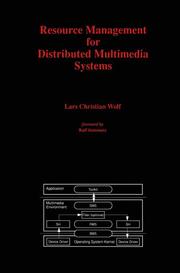Detailansicht
Resource Management for Distributed Multimedia Systems
ISBN/EAN: 9781461286134
Umbreit-Nr.: 4150534
Sprache:
Englisch
Umfang: xii, 146 S.
Format in cm:
Einband:
kartoniertes Buch
Erschienen am 27.09.2011
Auflage: 1/1996
- Zusatztext
- Inhaltsangabe1. Introduction.- 1.1 Motivation.- 1.1.1 Characteristics of Audiovisual Data.- 1.1.2 Resource Availability.- 1.1.3 Resource Management.- 1.1.4 Environment.- 1.2 Related Work.- 1.3 Outline and Relevance of this Work.- 2. System Architecture of the Multimedia Environment.- 2.1 Related Multimedia Environments.- 2.2 Basic System Architecture.- 2.2.1 Characteristics.- 2.2.2 Components.- 2.3 Execution Structure.- 2.3.1 Real-Time and Non-Real-Time Environment.- 2.3.2 Processing Model Approaches.- 2.3.3 Used Processing Model.- 2.4 Stream Management.- 2.4.1 Stream Handlers and Stream Handler Graphs.- 2.4.2 Purpose of the Stream Management.- 2.4.3 Centralized versus Distributed Stream Management.- 2.4.4 Operations of the Stream Management.- 2.4.5 Applications.- 3. Resource Management Principles.- 3.1 Resources to be Managed.- 3.2 Needed Resource Management Functionality.- 3.3 End-to-End Resource Management.- 3.3.1 Resource Reservation Protocols.- 3.3.2 Usage of a Resource Reservation Protocol.- 3.4 QoS Model.- 3.4.1 Purpose of QoS Description.- 3.4.2 Acceptable QoS Values.- 3.4.3 Pessimistic vs. Optimistic Resource Management.- 3.4.4 Workload Model.- 3.4.5 QoS Parameters.- 3.5 Resource Management System Structuring.- 3.5.1 Basic Architecture.- 3.5.2 Internal Structure.- 4. Resource Scheduling.- 4.1 Buffer Space Management.- 4.1.1 Mechanisms and Structure.- 4.1.2 Buffer Space Reservation.- 4.1.3 Related Work.- 4.2 CPU Scheduling.- 4.2.1 Scheduling Algorithm.- 4.2.2 Implementation.- 4.2.3 Evaluation.- 4.2.4 Related Work.- 4.2.5 Summary.- 4.2.6 Possible Client System Enhancements.- 5. Determination of Resource Requirements.- 5.1 Resource Requirements of Applications.- 5.1.1 Distributed Approach.- 5.1.2 Centralized Approach.- 5.1.3 Differences Between Distributed and Centralized Approach.- 5.1.4 Centralized Approach - A Closer Look.- 5.1.5 Advanced Features.- 5.1.6 Communication Between Stream Handlers.- 5.1.7 Buffer Space.- 5.1.8 Related Work.- 5.1.9 Summary.- 5.2 Buffer Space Requirements.- 5.3 CPU Processing Time.- 5.3.1 CPU Utilisation of Multimedia Processes.- 5.3.2 Components of the Measurement Tool.- 5.3.3 Operation of the Measurement Tool.- 5.3.4 Measuring Sink and Source Stream Handlers.- 5.3.5 Accuracy of the Measurements.- 5.3.6 Evaluation.- 5.3.7 Position of the Measurement Tool in the System.- 5.3.8 Related Work.- 5.3.9 Summary.- 5.3.10 Possible Simplification via Better Operating System Support.- 6. Reduction of Resource Requirements.- 6.1 Buffer Space Requirements.- 6.1.1 Approaches to Reduce Memory Space Requirements.- 6.1.2 Notation.- 6.1.3 Buffer Pool Models.- 6.1.4 Simulation of the Buffer Pool Models.- 6.1.5 Simulation Results.- 6.1.6 Implementation Issues.- 6.1.7 Summary.- 6.2 CPU Requirements.- 6.2.1 Necessary Characteristics.- 6.2.2 System Model.- 6.2.3 Scheduling Mechanisms for Processes with Known Arrival Times.- 6.2.4 Scheduling Mechanisms for Processes with Varying Arrival Times.- 6.2.5 Evaluation.- 6.2.6 Related Work.- 6.2.7 Summary.- 7. Advanced Resource Management Techniques.- 7.1 Reserving Resources in Advance.- 7.1.1 Related Work.- 7.1.2 A Model for Resource Reservation in Advance.- 7.1.3 Issues in Resource Reservation in Advance.- 7.1.4 An Architecture Exploiting ReRA Mechanisms.- 7.2 Scaling.- 7.2.1 Related Work.- 7.2.2 Advantages of End-System Aware Scaling.- 7.2.3 Scaling Mechanisms.- 7.2.4 QoS Class for Scaling.- 7.2.5 Exploiting Scaling Mechanisms.- 8. Conclusions and Outlook.- Appendix A.- A.1 Abbreviations.- A.2 Trademarks.- References.
